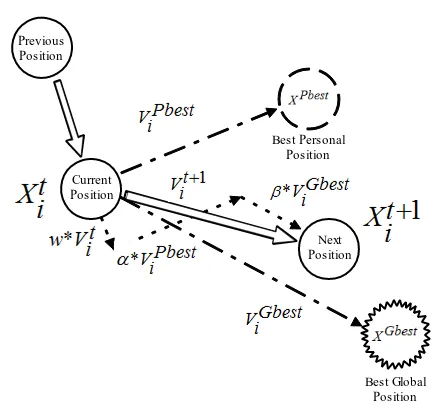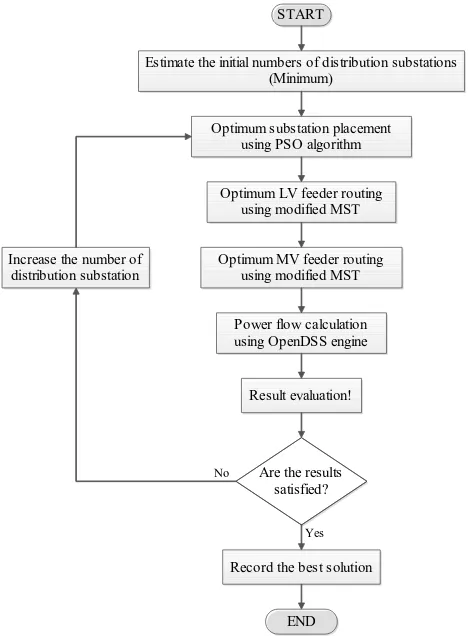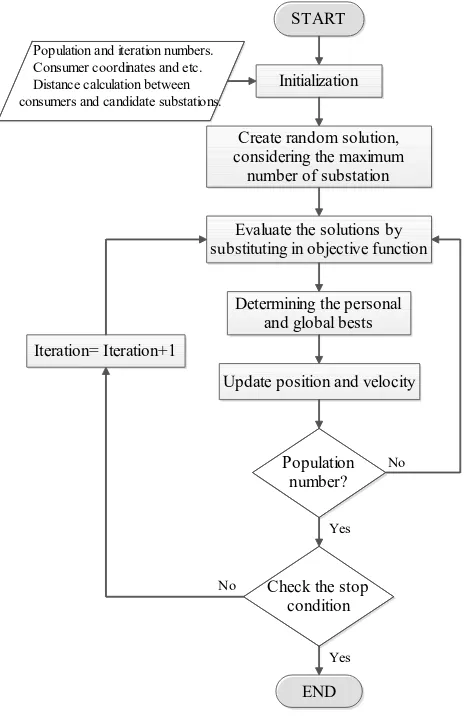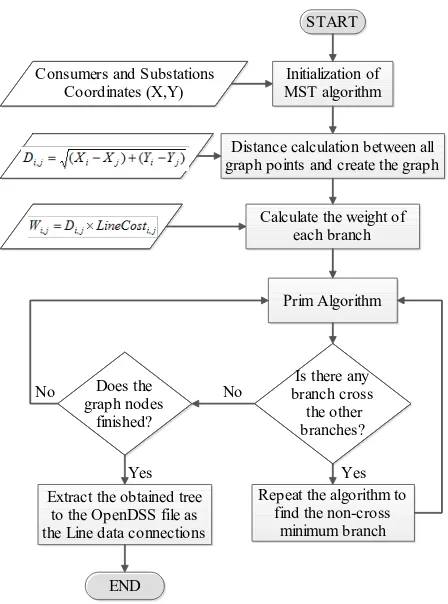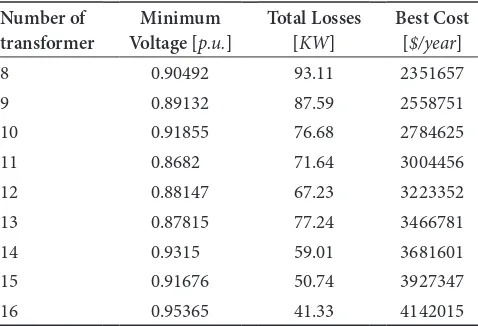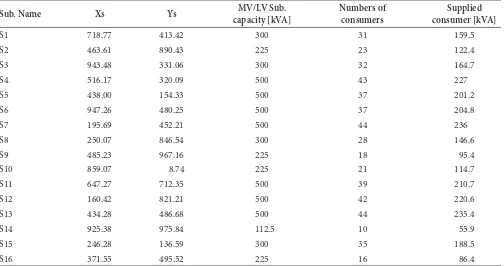Optimum Feeder Routing and Distribution
Substation Placement and Sizing using
PSO and MST
Ihsan Jabbar Hasan, Chin Kim Gan
*, Meysam Shamshiri, Mohd Ruddin
Ab Ghani and Rosli Bin Omar
Faculty of Electrical Engineering, Universiti Teknikal Malaysia Melaka (UTeM), Hang Tuah Jaya, 76100 Durian Tunggal, Melaka, Malaysia; [email protected].Abstract
A long term distribution network planning consists of several complexity aspects due to the multiple decision variables in objective functions. Optimum placement of distribution substations and determination of their sizing and feeder routing is
one of major issues of distribution network planning. This paper proposes an algorithm to find the optimum distribution substation placement and sizing by utilizing the PSO algorithm and optimum feeder routing using modified MST. The
proposed algorithm has been evaluated on the distribution network case with 500 consumers which are consisting of residential and commercial loads. The test network is generated by fractal based distribution network generation model
software tool. The results indicate the proposed algorithm has been succeeded to find the reasonable placement and sizing
of distributed generation with adequate feeder path.
Keywords: Distribution Substation Placement, MST, MV & LV Feeder Routing, OpenDSS, PSO
1. Introduction
he distribution network is a vital part of the electric power system. Distribution planners are always encoun-tered with several diiculties in designing due to the numbers of decision variables which are inluenced to distribution networks. Feeder routing in LV network and MV/LV substation placement and sizing are always one of the important challenges in distribution network planner. Meanwhile, it is crucial to reconigure the exist-ing distribution network due to the high load density and incremental cost of power distribution equipment and signiicant power losses in LV network (which is 50% of the total losses of power system).
Many researchers discuss about the complexity and diiculty of distribution system planning. In1 the optimal
feeder routing problem using the dynamic program-ming technique and Geographical Information Systems (GIS) facilities has been performed. he total cost of
investment, line losses and reliability has been taken to the account with related constraints such voltage drop and thermal issues. In2 GA has been used to solve the
optimum planning of large distribution network based on loss characteristics matrix for optimum substation loca-tion and graph theory for feeder routing in real size of distribution network. In3 the optimal planning of radial
distribution networks using simulated annealing tech-niques. he paper addressed the minimum capital cost by applying the steepest descent approach as initial solution and improved the obtained cost with simulated anneal-ing method. here are several method for distribution network modeling and planning which reference4 has
reviewed the some research work under normal condi-tion and emergency planning and modeling. In reference5
an attempt to reduce the cost of feeders by selecting the optimal conductor type and size of feeders segment. he paper performed a new computer algorithm and heuristic optimization technique.
Power low solution is one of the important sections of distribution network planning due to the vast of the network. herefore, this paper has tried to use OpenDSS engine as power low calculator in distribution network planning in order to extract the voltages and losses of the network during optimization procedures.
his paper performed the PSO algorithm to ind the optimal placement of substation and MST algorithm for optimal feeder routing in LV and MV networks.
1.1 Particle Swarm Optimization (PSO)
he swarm intelligent algorithm is one of the evolutionary computation methods which has introduced to solve the optimization problems and since then, their ability to be used in optimization problems has been demonstrated6.
In this method, the movement towards the optimal posi-tion is obtained from the best informaposi-tion of each particle which is included in the initial population (Best Personal Position) and the optimal position that is found by the neighbor’s positions (Best Global Position).
Researcher applied PSO algorithm successfully in complex non-linear engineering problem, principally in planning of distribution system, control systems, multi-objective optimization problems with multiple constraints, shape optimization and etc7. Since the
capaci-tor installation in distribution system has the non-linear and discrete equation, therefore, this paper utilized PSO algorithm as one of the accurate methods to solve the sub-station placement and sizing problem. he procedures of this algorithm have been described in8,9. Figure 1 shows
the particle movements bases on PSO algorithm.
1.2 Minimum Spanning Tree (MST)
his theory is assigned as one of the important part of mathematic sciences which has been introduced in 19s century. A graph is a collection of ordered pairs of branches and nodes that can be written as G∫( , ). Where, V is V E
node and E is branch. In fact, a graph is a diagrammatic model of a system. In general, a graph represents a binary relation between their system components. A single graph can have many diferent spanning trees that each branch can assign by weight. MST is the graph with the mini-mum weight on branches. here are a lot of algorithm to solve the MST problems which are Kruskal’s algorithm, Prim’s algorithm Dijkstra’s algorithm and etc. In2 the MST
algorithm has been implemented as feeder routing solu-tion in distribusolu-tion networks. his paper uses the prim’s
algorithm to solve the optimum feeder routing on LV and MV networks.
1.3 OpenDSS
he power low calculation is required in planning of distribution network to evaluate the network. To obtain this reason, the Open Distribution System Simulator (OpenDSS) is a comprehensive electrical system simu-lation tool for electric utility distribution systems. he OpenDSS is an open source developed by the Electric Power Research Institute10. he OpenDSS engine includes
the COM interface which can be used in other simula-tion programs such as MATLAB, VBA, C# and etc. he OpenDSS engine can help the researchers to obtain the variety of signiicant information about the simulated power system. In this paper, OpenDSS engine is utilized as a power low solution in order to ind the power system parameters such voltage proile, power factor, real and reactive power lowing in each line, power losses and etc. which can be used in optimum substation placement and sizing problem in distribution networks.
2. Methodology
Based on the new prospect of distribution networks plan-ning which is target to bring the small scale of substation beside the load centers in order to reduce the distribu-tion network losses, this paper has tried to introduce the initial adjustments of the algorithm based on this
Figure 1. Principle of the PSO particle movement.
Best Personal Position Previous
Position
Current Position
Best Global Position Next
purpose. herefore, the minimum numbers of distribution substations are estimated based on the maximum branch-ing rate and number of consumer (load centers) for each branch. In this paper, four branching rate for each substa-tion and maximum 15 consumers have been selected for each branch. Which means; minimum Sn substations are need for a network with n branches and m numbers of consumers for each branch, which Sn can be written as follows:
Sn= ¥
N
m n (1)
where, N is the numbers of the consumers. herefore, the estimation of minimum required substation can be con-sider as a irst step of optimization algorithm that shown in Figure 2.
he optimum substation placement will perform ater estimating the number of minimum required substations. For this purpose, the PSO algorithm has been utilized which it will be explained in following sub-section in
details. he optimum substation placement and sizing algorithm will generate the coordinates of each substation which has been connected to the particular consum-ers with adequate substation require sizing based on the number of supplied consumers as shown in Figure 5. he next optimization step will be the optimum LV and MV feeder routing using modiied MST algorithm. here are a few constraints and details that will be described in fol-lowing related section. Ater indicates the paths of feeders the next algorithm step is power low calculation using OpenDSS engine. herefore, the algorithm is generated OpenDSS codes for designing the network to run the power low and capturing required information for net-work assessment. he obtained results will be evaluated in the next step. he algorithm will record the captured solution, if the results have satisied in terms of substation placement standards, desire losses and in range voltage proile. If not, the algorithm will repeat once more time by increasing the number of distribution substation. his loop will continues to ind the best possible solution of the substation placement, routing and sizing whenever ind the optimum network designing.
2.1 Optimum Substation Placement
Using PSO
An adequate placement of distribution substation (MV/ LV) can be afected the other parts of distribution plan-ning such as primary/secondary substations and feeders routing in network planning. In other word, if the place-ment of substation is not done with adequate precision, the technical and economic diiculties will be encoun-tered to MV feeders and other parts of the distribution networks. herefore, determining the proper placement of distribution substations is crucial. In this paper a comprehensive algorithm for substation placement and determining the number of substation has been uti-lized. he Particle Swarm Optimization (PSO) method is performed to optimize the best possible placement of distribution substations. he only substation placement problem has considered in this section. Figure 3 illus-trates the PSO algorithm lowchart in terms of optimum distribution substation placement in LV network.
Figure 4 shows the consumers and candidate distribution substations with obtained from the fractal based distribution networks generation model tool11.
Figure 5 shows the numbers of selected substations ater optimization, which 16 numbers of distribution
Figure 2. he proposed lowchart of optimum substation placement and sizing and feeder routing for distribution networks.
START
Estimate the initial numbers of distribution substations (Minimum)
Optimum substation placement using PSO algorithm
Optimum LV feeder routing using modified MST
Optimum MV feeder routing using modified MST
Power flow calculation using OpenDSS engine
Result evaluation!
Are the results satisfied?
Record the best solution
END Increase the number of
distribution substation
substations has been selected among the 275 candidate substations. Meanwhile, this igure indicates the num-bers of consumers which assigned to their particular substation.
2.2 Optimum Feeder Routing using MST
As explained in introduction the prim’s algorithm has been utilizes in this paper to ind the optimum feeder routing of LV and MV networks. But the only prim’s algorithm cannot carry out our desire optimal routing. he modiied prim algorithm needs to be performed because of some technical requirement such as, open loop feeders and not allowed branches pass through each other. Figure 6 shows the proposed modiication algorithm using prim’s algorithm in MST in order to ind the optimum feeder routing in distribution network.
Figure 7 shows the obtained results ater LV and MV feeder routing using modiied MST algorithm. It depicts the LV feeder path with purple line color and MV con-ductors by black line color. he LV feeders are connected adequately without passing each other as shown in igure. It demonstrated the modiied algorithm has succeeded to solve the feeder routing problem by considering the prob-lem constraints.
3. Problem Formulation
In distribution system planning, the geographical dis-tribution of loads density and allocation of feasible candidate substations are the important information in the study year. Based on optimization point of view,
Figure 3. he optimum substation placement lowchart using PSO.
START
Initialization
Create random solution, considering the maximum
number of substation
Evaluate the solutions by substituting in objective function
Determining the personal and global bests
Update position and velocity
Population number?
Check the stop condition
END
Population and iteration numbers. Consumer coordinates and etc. Distance calculation between consumers and candidate substations.
Iteration= Iteration+1
Yes
Yes No
No
Figure 4. Consumers and candidate substation.
0 200 400 600 800 1000
0 200 400 600 800 1000
X [m]
Y [m]
Consumers Candidate Substation
Figure 5. Selected MV/LV substations ater optimization.
0 200 400 600 800 1000
100 200 300 400 500 600 700 800 900
X [m]
Figure 6. he lowchart of modiied MST algorithm in order to solve the optimum feeder routing in distribution network.
START
Initialization of MST algorithm
Distance calculation between all graph points and create the graph
Calculate the weight of each branch
Prim Algorithm
Is there any branch cross
the other branches?
Extract the obtained tree to the OpenDSS file as the Line data connections
END
Repeat the algorithm to find the non-cross
minimum branch Consumers and Substations
Coordinates (X,Y)
Does the graph nodes
finished?
Yes Yes
No No
Figure 7. Obtained network ater optimum feeder routing for LV and MV in 164 consumers distribution network.
0 200 400 600 800 1000 242265245 297 149151165 167 355 363364 371
390 417 420
428 430 434 444 440
447 190222248201
271
442449 443 473475 d) cost minimization of new substation construction. Accordingly, the objective functions of substation place-ment and sizing can be formulated as follows:
CL CL PLossi
losses at consumer i and nlb is the number of consumers. he investment cost of substation should be annui-tized to able to accumulate with other network costs13.
hus, to annuitize the investment cost of distribution net-work, the following economical consideration should be performed. ixed cost of substation j. he variable cost of substation included the cost of operation and maintenance, and the ixed cost consists of installation and other related ix cost of substation such as land and equipment prices and etc.
hus, the main objective function that needs to be minimized can be written as follows:
Min Z=CL CC PF+ + (8)
where Z is the total cost function and PF is the penalty factor which is calculated by the optimization constraints. For instance, if the voltage is out of the deined range, therefore the violation amount of voltage will multiply to the constant ine rate (Beta) which can be written as follows:
PF Violationi
i nv
= ¥
=
Â
(b ) 1(9)
where, nv is number of violations and β is the ine rate. he irst constraint of distribution network planning is acceptable voltage drop at receiving bus (Vi) which volt-age should be within the speciied range.
0 95. £ £Vi 1 05. (10)
he next constraint of distribution network planning is the longest distance of each consumer from the distri-bution substation which introduced by substation radius based on standard. To consider this constraint the follow-ing condition must be considered:
Dij£Rmaxj (11)
where Dj i
is stand for distance between substation j to consumer i and Rmaxj is the maximum acceptable radius of substation j that can supply the consumers. Based on the standard, in LV feeder the maximum length of feeder can be up to 0.5–1 km. In urban networks, the length of 11 kV feeders in generally up to 3 km and for rural networks is up to 20 km.
4. Result and Discussion
he fractal based distribution networks generation model tool has been utilized in this paper to generate a distri-bution network test system. he initial assumptions of the utilized distribution network model are as, 275 MV/ LV candidate distribution substations and 500 consum-ers. Table 1 shows the distribution network consumer demands which generated by the prescribed tool. his case has been used in this paper in order to demonstrate the functionality of proposed algorithms of substation placement and sizing in distribution network and feeder routing in both LV and MV networks.
Table 1. Consumer Demand Data
Type of
consumer Percentage
No.of Customers
Maximum Load [kW]
Residential (Double Story house)
90% 450 5
Residential (Bungalow house)
10% 50 7
As shown in Figure 5 the number of selected distribu-tion substadistribu-tion is 16 numbers ater optimum placement through 275 substation candidates. Table 2 shows the optimization procedure to select the number of required substations with considering the acceptable voltage drop and minimum losses of networks. Table 3 indicates the selected the substation size of transformers ater opti-mization. he voltage drop based on distance for all distribution substations and 500 consumers are shown in Figure 8. It indicates all the buses allocated within the standard range of voltage drop which stated in previously sections. In Figure 8, the dotted line and continuous line indicates LV and MV voltage proiles, respectively. An MV/MV substation (secondary substation 33/11 kV) is placed at the ix position which as shown in Figure 7 and the selected substation size is shown in Table 4 .To select the size of substation sizing has been tried to follow the standard of distribution transformer by IEEE/ANSI C57.12.0014.
Table 2. he PSO progress in diferent number of
substations
Number of transformer
Minimum Voltage [p.u.]
Total Losses [KW]
Best Cost [$/year]
8 0.90492 93.11 2351657
9 0.89132 87.59 2558751
10 0.91855 76.68 2784625
11 0.8682 71.64 3004456
12 0.88147 67.23 3223352
13 0.87815 77.24 3466781
14 0.9315 59.01 3681601
15 0.91676 50.74 3927347
Table 3. Selected size of MV/LV transformers ater optimization
Sub. Name Xs Ys MV/LV Sub.
capacity [kVA]
Numbers of consumers
Supplied consumer [kVA]
S1 718.77 413.42 300 31 159.5
S2 463.61 890.43 225 23 122.4
S3 943.48 331.06 300 32 164.7
S4 516.17 320.09 500 43 227
S5 438.00 154.33 500 37 201.2
S6 947.26 480.25 500 37 204.8
S7 195.69 452.21 500 44 236
S8 250.07 846.54 300 28 146.6
S9 485.23 967.16 225 18 95.4
S10 859.07 8.74 225 21 114.7
S11 647.27 712.35 500 39 210.7
S12 160.42 821.21 500 42 220.6
S13 434.28 486.68 500 44 235.4
S14 925.38 975.84 112.5 10 55.9
S15 246.28 136.59 300 35 188.5
S16 371.55 495.52 225 16 86.4
Figure 8. he voltage drop based on consumer and substations distances.
Table 4. Selected size of secondary transformer (33/11) kV ater optimization
Substation name
[33/11]kV X Y
Substation capacity [kVA]
Numbers of supplied MV/LV substations [11/0.4]kV
Total apparent power demand [kVA]
ES1 54 58 5000 16 2669.8
5. Conclusion
In conclusion, this paper has proposed the algorithm based on combination of PSO and MST to solve the distribu-tion network planning in terms of substadistribu-tion placement, sizing and feeder routing. he proposed algorithm has performed on the test distribution network model with 500 consumers and 275 candidate distribution substa-tions. he results demonstrate the proposed algorithm has succeeded to ind the suitable placement and sizing of distributed generation with adequate feeder path.
6. Acknowledgement
7. References
1. Boulaxis N, Papadopoulos M. Optimal feeder routing in distribution system planning using dynamic programming technique and GIS facilities. IEEE Transections on Power Delivery. 2002; 17(1):242–7.
2. Najai S, Hosseinian SH, Abedi M, Vahidnia A, Abachezadeh S. A Framework for Optimal Planning in Large Distribution Networks. IEEE Transections on Power Systems. 2009 May; 24(2):1019–28.
3. Nahman JM, Peric DM. Optimal Planning of Radial Distribution Networks by Simulated Annealing Technique. IEEE Transections on Power Systems. 2008 May; 23(2):790–5. 4. Khator SK, Leung LC. Power distribution planning: a review
of models and issues. IEEE Transections on Power Systems. 1997; 12(3):1151–9.
5. Islam S, Ghani M. Economical optimization of conductor selection in planning radial distribution networks. IEEE conference on Transmission and Distribution Conference. 1999; 2:858–63.
6. Kennedy J, Eberhart R. Particle swarm optimization. IEEE International Conference on Neural Network. 1995; 4:1942–8.
7. Taher SA, Karimian A, Hasani M. A new method for optimal location and sizing of capacitors in distorted distribution
networks using PSO algorithm. Simulation Modelling Practice and heory. 2011 Feb; 19(2):662–72.
8. Shamshiri M, Gan CK, Jusof K, Hasan IJ, Ruddin M, Yusof M, Engineering E, Utem M, Jaya HT, Tunggal D, Jaya T. Using Particle Swarm Optimization Algorithm in the Distribution System Planning. AJBAS. 2013; 7(3):85–92. 9. Hasan IJ, Gan CK, Shamshiri M, Isamdi BB, Ruddin
GAM. Losses Reduction and Voltage Improvement Using Optimum Capacitor Allocation by PSO in Power Distribution Networks. IREMOS. 2013 Aug; 6(4):1219–26. 10. Dugan R. OpenDSS Introductory Training Level I. EPRl.
2009.
11. Gan CK. Strategies for design of future distribution networks [PhD hesis]. Imperial College; London: 2011. 12. Eajal A, El-Hawary M. Optimal capacitor placement
and sizing in distorted radial distribution systems part III: Numerical results. ICHQP, Bergamo, Italy, 2010, pp. 1–8.
13. Gan CK, Mancarella P, Pudjianto D, Strbac G. Statistical appraisal of economic design strategies of LV distribu-tion networks. Electric Power System Research. 2011 Jul; 81(7):1363–72.
